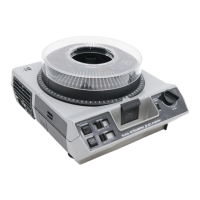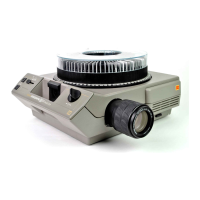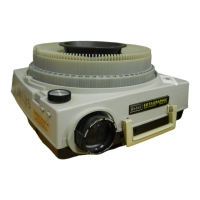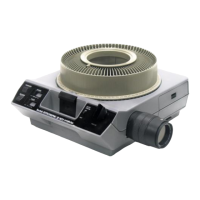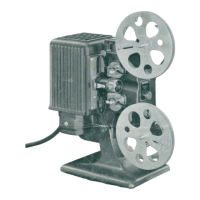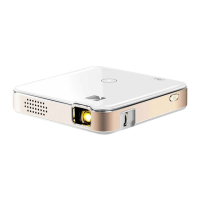Do you have a question about the Kodak EKTAPRO and is the answer not in the manual?
Identifies key components of the Kodak Ektapro 320 slide projector with numbered parts.
Details safety marks (UL, CSA, VDE) and CE conformity for EMC and product safety.
Lists standards related to radio interference compliance (EEC, AS, RFS, VCCI, FCC).
Explains symbols like action arrows, reference arrows, and framed warnings for manual guidance.
Provides essential safety precautions for operating and handling the projector, including handling hot parts and electrical safety.
Ensures correct voltage setting before powering on to prevent projector damage.
Steps to connect the projector to mains and turn it on using the mains switch.
Procedure to safely change the projector's operating voltage by adjusting the fuse link.
Steps to load slides correctly into the tray and install it onto the projector.
Advice on using specific slide mounts (light, gray) with the Extra Bright Lamp Module to prevent issues.
Discourages use of non-specified lamp types (EXW/15h) that can cause deformation.
Methods to reduce slide temperature, including using heat-absorbing filters or 200h lamps.
Explains the tray positioning index mark for correct installation, especially from the rear.
Instructions for fitting spiral grooved and gear rack lenses into the projector's lens mount.
How to adjust the projector's height using the slide-forward button and adjustable feet.
Guidance on placing the projector on a stable surface and permissible projection angles.
Emphasizes the need for proper ventilation, keeping air inlets and outlets clear.
Detailed steps for manually focusing the image using projector buttons or the focusing knob.
Describes how to change slides using projector buttons or the remote control.
Explains rapid tray movement and setting the tray to the zero position.
Methods to move the slide tray to its zero position using projector buttons, remote control, or mains switch.
Procedure for removing the slide tray in emergencies, ensuring correct re-installation alignment.
Using the IR Remote System for fast, random access to any slide within approximately 5 seconds.
Warning against operating the projector with an external timer.
Connecting two projectors in parallel using the Twin Socket Adapter and cable.
Operating multiple projectors simultaneously with IR Receivers, ensuring same channel setting.
Crucial safety warning to switch off and unplug before fuse replacement.
Steps for replacing the primary circuit fuse by accessing the fuse link compartment.
Critical safety warnings for lamp replacement, including cooling and avoiding touching the bulb/mirror.
Step-by-step guide for safely removing the old lamp module and installing a new one.
Information regarding the one-year guarantee on the original projector, excluding accessories and lamps.
Safety steps for cleaning: switch off, unplug, and allow to cool down.
Instructions for cleaning the projector's housing with soft cloth and optics with lint-free cloth/tissues.
A table listing common operational problems, their possible reasons, and help solutions.
Lists various KODAK EKTAPRO FF Lenses, lens support, and slide trays.
Details IR Remote Systems, extension cables, and twin socket adapters for system connectivity.
Information on Extra Bright Lamp Modules, standard heatfilters, and heatfilters +10.
Includes carrying cases, twin socket connecting cables, and 4x4 condenser kits.
Projector measurements, weight, and slide tray capacity details.
Supported slide formats (24x36mm, 4x4) and slide gate mechanism.
Information on the universal lens mount, height adjustment, and projector levelling angles.
Details on Extra Bright Lamp Module, projection lamps, and safe operating temperature.
Power voltage, frequency, fuses, external unit supply, and 8-pin socket pinout.
Projector performance, slide change/access times, and control via contacts.
Specifications for KODAK Slide Projection FF Lenses, including coating, length, weight, aperture, elements, and field angle.
Specifications for KODAK EKTAPRO SELECT FF Lenses, detailing coating, length, weight, aperture, elements, and field angle.

